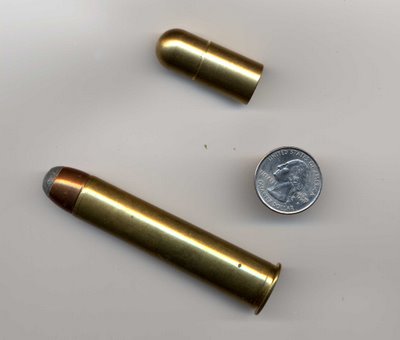There's not much to say about the guy who spends $2000 to have the latest gear in his deer stand for the one weekend a year he spends shivering in a deer stand plugged into his Ipod, waiting for a bigger pair of antlers than the ones he's always got mounted on the wall to happen by.
I don't get it.
Neither do I have much to say about the wealthy "sportsman" who'll invest a fortune, often upwards of $100,000, on an exotic hunt in a foreign venue to "collect trophies" (or compensate for some shortcoming), particularly if he's looking to add to or "improve" his collection of dangerous species ... animals like Cape Buffalo, leopard, lion, hippo, elephants and crocodiles.
You might be shaking your head, "But if the guy's got a gun how can any animal be dangerous?"
I'm no expert, but two hours of wading through head-high grass in 100 temperatures with your vision limited to about two feet ... accompanied by the certainty there's 1500 pounds of irate muscle cocked behind the horns of the creature who knows where you are and is waiting to unzip you like an old gym bag probably shifts the odds a little bit towards the animal's favor.
Just saying.
It's not by accident that African game departments are stubbornly reluctant to release figures revealing how many professional hunters and clients are killed each year by their quarry; newspaper reports dissecting the aftermath of a lion mauling or a sound stomping by elephant could make stink for the safari business. But from hearsay and anecdotal evidence, the numbers of hunters killed, maimed or crippled in the bush would certainly evoke standing ovations back at PETA headquarters.
Dangerous Game is called "dangerous" for a reason: each and every animal on the list is spendidly customized to hurt, rip and kill trophy collectors in a remarkably slow, excruciating and intensely personalized fashion.
The problem is that most "sportsmen" wealthy enough to participate are surprisingy indignant about visualizing themselves being mauled, shredded or eaten by wild beasts, particularly if the Game Department's official post-game recap indicates the hunter/victim was killed trying to run away.
How humilating that would be for the poor fellow's Investment Manager, for the company shareholders and for his buddies on the 18th fairway ... not to mention how glum he'd feel knowing his trophy wife and her poolboy will likely squander what's left of his fortune on some beach in the Med. So the risks of Dangerous Game Hunting must be carefully tallied and managed, else very few wealthy "sportsmen" would be inclined to even consider it.
Since the 1920s when motorized vehicles helped introduce privileged "sportsmen" to African hunting, it's probably safe to say 99.999% of hunters shoot their trophies from very safe distances ... often at ranges between 50 and 100 yards.
But is dangerous game really "dangerous" if it's standing so far away the hunter needs a scope to see what he's shooting? Why not just shoot the animal in a cage if it's never given a chance to level the hunter's playing field, and bite back?
Sorry; I've wandered away from the point.
I love elephants, and if you run across one today I'm begging you not to shoot it. Elephants are wonderful, amazing creatures ... who also get particularly nasty when approached or offended.
But a hundred years ago ... any man with nothing more than dependable nerves and the skill to fire an adequate rifle accurately could earn enough money to retire and pen his memoirs working just a handful of years hunting ivory.
It's a fact that those days are far, far behind us ... so indulge me a bit if I've attached an un-pc romance to that long-ago era when a man could still earn a fortune with sweat, stamina and skill.
Elephants are extremely intelligent, social creatures known to protect and defend each other against threats ... including the two-legged designer-khaki clad variety. Un-wounded elephants are particularly notorious for disappearing into heavy brush at the first sound of a shot, waiting, and then charging unaware hunters at the time and place of their choosing. Intuitively, elephants seem to sense when hunters are distracted, or offguard and unaware.
You want that kind of team spirit if you're an elephant, but would much rather avoid being the recipient of some tusk n' trunk payback if you're the hunter. A man who glances up to find an angry elephant rushing to welcome him to the neighborhood is left with frustratingly few choices and precious little time to react.
There's no point throwing the rifle down and asking for a head start because even the chubbiest, most flat-footed elephants can outrun Olympic sprinters. Elephants have also been known to use their trunks to pluck fleeing hunters down from trees and then ruin that person's day with great gusto. And those tusks aren't there for decoration or tourist postcards, either.
You can try shooting, but by that time only a properly-placed shot through four feet of skull will reliably put on the brakes ... remember the target, about the size of a football turned head-on, is coming towards you at precisely the same speed as Mr. Mad Peanut.
That trumpet blast you hear as you see the whirlwind of dust swirling behind his legs means two things: he's letting his friends know he's found you; it's also his way of saying he can't wait to be introduced.
Probably in part because professional ivory hunting back in the day lacked formal medical, retirement or funeral plans, in 1903 a new rifle/cartridge was introduced to help keep ivory hunters out of convalesent homes and cemeteries ... the .600 Nitro Express.
The .600 Nitro was the only cartridge ever designed from scratch to stop charging elephants in their tracks. Being far too powerful for most anything else, I've read that between 1903 and World War II only about fifteen (15) .600 Nitros were ever sold.
Another reason for the comparitively low figure is that by 1903 professional ivory hunting was already on its way out; maybe the real reason was the .600's fierce recoil ... about like lodging five 12-gauge shotguns against your shoulder and firing them simultaneously, a sensation which leaves many shooters wondering if a thorough tusking wouldn't be less unpleasant.
The .600 Nitro's rarity combined with a reputation as "the most powerful" guaranteed its place in the leathery annals of African lore. I got the chance to fire a .600 in Africa last year.
The first thing folks familiar with rifles ask is always, "What's it feel like?"
This is what it's like: It feels just like lying on the floor and having a 125-pound weight dropped onto your shoulder and jaw from a height of one foot. That's exactly what it feels like. Firing several shots in succession makes the trees spin; a headache is inevitable and for a few minutes afterwards even walking becomes uncertain.

But even the .600 has limitations when mixed with elephants. There's a published account of a professional named Petersen who, about 90 years ago, fired both barrels of his .600 into a charging elephant, which then used its trunk to ... well, never mind the description except that it demonstrates elephants are both imaginative and creative.
If you love elephants like I do it might be enough to know that Elephants always play to win, and that they often win quite convincingly.


No comments:
Post a Comment